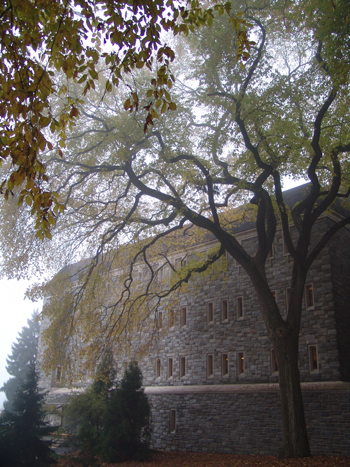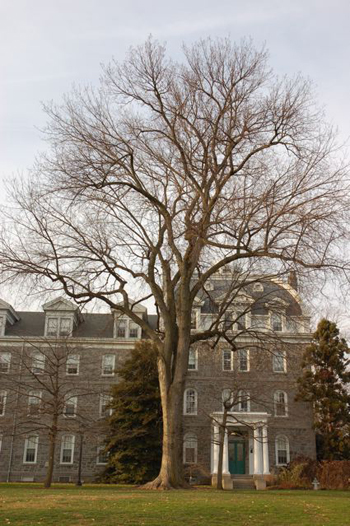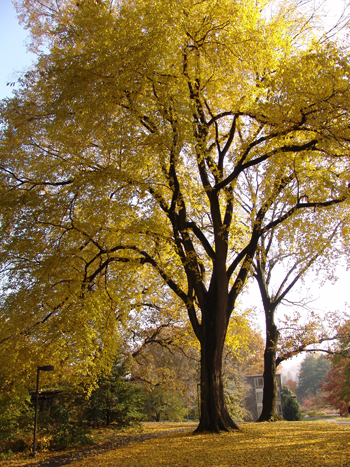American Elms at Scott

While the Arboretum was founded over 80 years many of the most fantastic tree specimens at the Arboretum were planted by the early founders of Swarthmore College. On the campus there are nine remaining specimens of the American elm, Ulmus americana which pre-date the Arboretum (founded in 1929). Many of these were class trees in the late 1800’s. One of the finest of these elms resides just outside of the Terry Shane Teaching Garden behind McCabe Library. This elm is the class tree of 1875.

Ulmus americana of the orginal planting in front of Parrish Hall. photo credit: T. Zetterstrom
On December 14th Tom Zetterstrom, a nationally recognized photographer of trees, visited with Julie Jenney and me. In addition to his photographic work, Tom has been documenting outstanding specimens of American elms, especially in the Northeast. Tom commented that the class tree of 1875 is as big or possibly even bigger than any elm in Massachusetts.
The American elm has been devastated by Dutch Elm Disease. It was one of the predominant shade trees that lined the streets in residential neighborhoods throughout the Northwest. In areas where American elms were planted as monocultures the effects of this disease was catastrophic.

American elm in fall color. photo credit: R. Maurer
At Swarthmore College, elms were planted in profusion years ago. At the front of Parrish Hall there was a row of specimen American elms that almost all succumbed to Dutch Elm Disease. Of that planting one plant remains at the east end of Parrish in the front. Other fantastic specimens at the Arboretum include one behind McCabe Library; Ashton House; two along the train tracks in the Pinetum, at the west end of Parrish Hall, and a beautiful weeping specimen near the softball fields along Field House Lane.
Today, the specimens at the Arboretum are treated every other year with Arbortect which is a fungicide that is injected through several tiny holes at the base of the tree through the bark.





John Manion
Posted at 08:55h, 22 JanuaryBecky: very nice article, and stunning images! I did a piece for the Hybrid on the Arboretum’s elms when I was an intern there. Keep up the wonderful work you all do…I always enjoy these “Garden Seeds!”
Becky Robert
Posted at 09:17h, 22 JanuaryThanks John. It is actually Andrew’s article. I hit the wrong key when I posted the article. I have corrected the author. I will pass along your comments to him. He also does great work for our blog.
Drew Peogn
Posted at 10:56h, 22 JanuaryRefresh my memory – are there any elms in the pipeline that are resistant to Dutch Elm Disease? I know there’s an extensive Chestnut breading program.
Andrew Bunting
Posted at 14:50h, 22 JanuaryDrew,
Yes, there are several that have been produced that show great resistance to Dutch Elm Disease such as ‘Valley Forge’, ‘New Harmony’, etc.
Andrew
Tom Zetterstrom
Posted at 12:21h, 23 JanuaryI wish to add mention of two DED (Dutch elm disease) resistant American elm cultivars–‘Princeton’ which is most readily available in the market, and ‘Jefferson’ a more recent introduction with stronger U-shaped branch unions.
Rigorous testing by the National Arboretum makes these along with ‘Valley Forge’ and ‘New Harmony’ reliable choices for elm restoration.
For our elm preservation program Elm Watch also recommends macro-injection of Arbotect into the trunk flare. It is generally understood that micro-injection capsules provide uneven crown protection from DED.
Julie Vrooman
Posted at 22:30h, 25 JanuaryMy favorite is the enormous elm by the railroad tracks – and it is our state champion!
Andrew Bunting
Posted at 08:57h, 26 JanuaryThat is my favorite too. you can see the beautiful silhouette unobstructed. It also has a fantastic gnarly, buttressed base that is incredibly architectural.
Craig McDonald
Posted at 11:08h, 28 JuneI have an American Elm it seems in my front yard. It is about 80′ tall with a large spread. I did not know that it was an Elm until now. I am concerned about the leaves falling and growing sparse. I compared the leaves through google to see what kind of Elm it is. The leaf compared to that of the American Elm. I am by no means a tree person who keeps up with these things, however I do enjoy the tree and I do not want my tree to die. You are an expert in this and I am just an average guy looking for advice.
Sincerely,
Craig McDonald
Andrew Bunting
Posted at 10:39h, 01 JulyCraig,
Where in the country do you live. Maybe I can suggest a tree expert to look at your tree.
Andrew Bunting, Curator